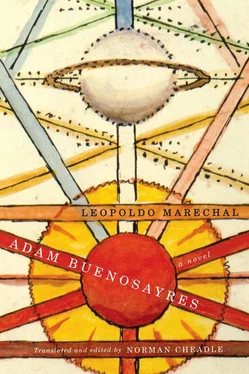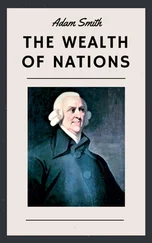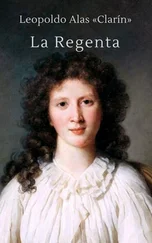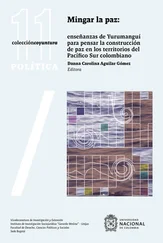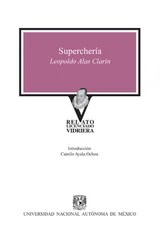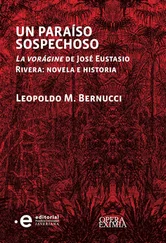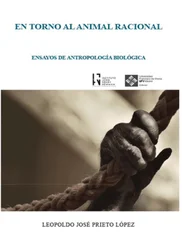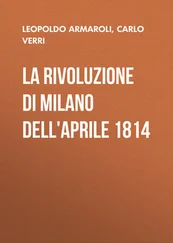13 The coat-of-arms of the city of Buenos Aires indeed shows a dove symbolizing the Holy Spirit, which hovers above two ships at anchor, signifying the city’s twofold founding, first by Pedro de Mendoza (1516) and definitively by Juan de Garay (1580) (website of Gobierno de la Ciudad de Buenos Aires). Barcia (200n) notes that the cover illustration of the second edition of Adán Buenosayres (1966) reproduces the city’s coat-of-arms, but in Samuel’s satirical version with the dove replaced by a hen.
14 Catamarca is a province in the northwest of Argentina, bordering on Chile. Irma would likely be an internal migrant, having left her economically depressed home in search of employment in Buenos Aires.
15 In the original, Samuel ironically addresses Adam with the honorific Musajeta , a term correctly spelled in Spanish as musageta (< Greek and Latin, musgetes “guide of the Muses,” one of Apollo’s epithets). The orthographic change is sly: jeta in Spanish means “snout” and is used as a jocular term for nose.
16 The Amundsen tertulia is a fictional version of the Lange family tertulia, which was held every Saturday afternoon, not Thursday. Besides the liturgical resonance of (Holy) Thursday, Marechal may have chosen Thursday rather than Saturday in homage to his admired nineteenth-century writer Lucio V. Mansilla (1831–1913), whose weekly newpaper column Causeries del jueves [Thursday Chats] was bound and published in five volumes under the title Entre nos (1889–90).
17 “El primer cuidao del hombre / es defender el pellejo.” The two lines are from stanza 2,313 of La vuelta de Martín Fierro (1879) [The Return of Martín Fierro], by José Hernández, sequel to his narrative poem Martín Fierro (1872). In the poem, the speech is pronounced by the Viejo Vizcacha , a wily and unscrupulous character named after a rodent, considered to be a pest, indigenous to the Southern Cone.
18 Ricardo Rojas (1882–1957): a writer of the Novecentista generation, notable for its celebration of the 1910 centenary of Argentine independence. Rojas wrote an eight-volume history of Argentine literature and culture, La literatura argentina: Ensayo filosófico sobre la evolución de la cultura en el Plata (1917–1922) . In this passage Samuel pokes fun at one of Rojas’s literary ticks.
19 Gloria Videla (174), discussing the intertextuality between Ortega y Gasset, Eduardo Mallea, and Marechal, relates Samuel’s contrasting cities of the chicken and the owl to Mallea’s thesis of the two Argentinas, one visible and vulgar, the other invisible and spiritually superior. Residents of the former enjoy “an eminently bourgeois satisfaction… a state of comfort… a contentment without glory”; the latter are “profound, subterranean, called to a tragic existence.” The former, “garrulous and happy,” are merely play-acting or faking [ representando ]; the latter are creating (Mallea 365).
20 Samuel spoofs the conventions and stereotypes of the sainete , the popular, melodramatic theatrical form that in 1920s reflected the dramas of the lower classes, many of whom were immigrants (Navascués, AB 142n).
21 Perhaps a parodic allusion to the angel with whom Jacob wrestles in Genesis 32:23–32.
22 The bucolic project is surely a reference to the East-European Jewish settlement in the Argentine pampas in the late nineteenth century, a project sponsored by the Jewish-Belgian Baron Maurice de Hirsch, as well as to that settlement’s literary consecration in Alberto Gerchunoff’s book Los gauchos judíos (1910) [The Jewish Gauchos]. The redemptive vision of Jewish farming was part of the same European Jewish ideology that gave birth to Zionism. Gerchunoff aimed to achieve Jewish assimilation and acceptance by Argentine society by rhetorically marrying Jewishness to gaucho-ness, the latter being a contemporary symbol of Argentine authenticity. As Edna Aizenberg observes (20), Gerchunoff deliberately employed linguistic archaisms, quoting medieval Sephardic texts and paraphrasing Don Quixote , in an attempt to reaffirm the Jews’ historical roots in the Hispanic world and thus legitimate their presence in Argentina. The book, along with its assimilationist project, was enormously successful among Argentine Jews and Gentiles alike, spawning imitations and movie versions. It effectively founded the lineage of Argentine-Jewish literature.
23 An allusion to Count Hermann Keyserling’s South American Meditations (1932), which devotes an entire chapter to “Sorrow.” Keyserling’s rather patronizing thesis is that South American humanity is stuck in the “Third Day of Creation,” a vegetative, chthonic reality imbued with a passive, suffering sadness. In a dialectical twist, however, he praises this condition: “ South American sadness is worth more than all North American optimism and all Neo-European idealism ” (310; Keyserling’s italics). Raúl Scalabrini Ortiz (real-life model for Bernini) took up the notion of Argentine sadness in his famous essay “El hombre que está solo y espera” (1931) [The Man Who Is Alone and Waits/Hopes]. Keyserling was one of many prominent European thinkers and writers who were attracted to visit Buenos Aires in the 1920s and 1930s: among them were Spanish literary critic Guillermo de Torre, Spanish avant-garde writer Ramón Gómez de la Serna, Spanish philosopher José Ortega y Gasset, French Fascist intellectual Pierre Drieu la Rochelle, French Catholic intellectual Jacques Maritain, and Italian Futurist poet Filippo Tomasso Marinetti.
24 Macedonio Fernández (see 637n9). The original phrase, from his experimental metaphysical essay “No toda es vigilia la de los ojos abiertos” (1928) [Not All Consciousness Is of the Waking Kind] is a poetic formulation of his doctrine of “absolute subjectivism or idealism.” Being, writes Maedonio, is “un almismo ayoico” (25), literally: a non-selfish soul-ism or soulishness. One of Macedonio’s chapter titles is “El mundo es un almismo.” Marechal has combined the two phrases: “El mundo es un almismo ayoico.” This neologism is consonant with Macedonio’s assertion that the Yo [the “I,” the Self] is an invention of our “grammatical genius,” but that it lacks all substance or content. Samuel Tesler’s reply is: “El mundo es un yoísmo al pedo,” which more literally translated would be: “The world is a vain egoism, useless as a fart.”
25 Twice Samuel insists on giving Adam Buenosayres a lesson in frankness, the second time assuming the mantle of the European master. This looks like a satirical allusion to Ortega y Gasset’s contention in “El hombre a la defensiva” that “in normal social intercourse the Argentine [man] does not let himself go; on the contrary, at the approach of another, he locks up his soul and goes on the defensive… Whereas we [Europeans] let ourselves go and lose ourselves with complete sincerity in the theme required by the conversation, our [Argentine] interlocutor adopts an attitude” of petulant self-importance (Ortega 643). Ortega goes on to develop at length the metaphor of the mask behind which the insincere Argentine defensively hides. But in a sly manoeuvre, Marechal has Samuel, master of the masks, impersonate the “sincere” European.
26 Philography (Sp. Filografía ): a term denoting the Neoplatonic Renaissance genre of “writing about love” initiated by the exiled Iberian Jew León Hebreo in his Dialogues of Love (1535), which take the form of allegorical conversations between Sofía (Wisdom) and Filón (Lover). León Hebreo was forcibly exiled from Portugal in 1483 and then from Spain in 1492. His work was published posthumously in the Tuscan dialect in Rome in 1535. The best (re)translation to Spanish is Diálogos de amor (1587), by the Inca Garcilaso de la Vega. Son of a Spanish conquistador and an Inca princess, Garcilaso remains in the Latin American imaginary as a powerful figure of racial and cultural mestizaje . León Hebreo’s book and its various translations ended up on the index of books prohibited by the Inquisition.
Читать дальше
